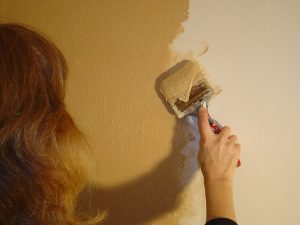Thanks to Sigi Koko of Build Naturally.
Whether it’s for your kitchen walls or your 5 year old’s latest masterpiece, Sigi Koko shares her simple recipes for homemade natural paint with milk.
Milk paint, also called casein paint, is actually made from the curds of the milk, so first you sour it to separate the curds from the whey (instructions to follow below). Milk-based paints work well on a variety of absorbent surfaces, such as drywall, clay plaster, clean wood, or paper. The resulting paint has a slight sheen. It is wipe-able with a damp cloth but not scrub-able, so don’t use it on surfaces that get scrubbed clean. That said, if you use milk paint on wood, you can then seal the wood with tung oil or linseed oil for an incredibly beautiful and durable finish. This is a great paint to make with kids! My niece likes to paint with milk paints when she visits.
To make the curds…
To separate the curds from the whey, you basically are souring milk. You can do this one of two ways: 1) let your milk stand in a warm place for several days, undisturbed, and with the lid slightly off OR 2) you can speed the process up by adding 1/2 cup of white vinegar or lemon juice per gallon of milk. The key is to leave the milk completely undisturbed in order for the curds to develop into large particles. If you shake or stir the milk while it is souring, the curds become small and difficult or impossible to strain out. There is a fabulous instructional video by Earth Pigments Company below.
I have had the best results with 1% or 2% milk, but theoretically any milk will work. Once your milk has soured and separated, you will see white chunks floating over a clear yellowish liquid. This means your milk is done! Strain the curds through a fine strainer or in cheese cloth to discard the liquid-y whey. If you are painting walls, I recommend rinsing the curds in cold water a few times to remove any residual whey.
To make milk glaze…
This recipe is for a translucent pigmented glaze that will cover approximately 40 square feet.
1 cup strained milk curds (see above)
1½ tablespoon borax (available in the laundry aisle of most supermarkets; optional but I always add it if I’m painting a wall)
¼ cup hot water
Approximately 2 tablespoons pigment (or as desired)
Dissolve the borax completely in the hot water. Then slowly whisk into the strained milk curds. Stir thoroughly until lump-free. Add pigment to the desired colour. This will make a translucent glaze-type paint. If you want to make an opaque paint, you can add 1/2 cup whiting (purchased from an artist supplier and soaked in water overnight) to the recipe above.
Tip for adding pigment: you can soak your pigment in water overnight and then strain it through cheesecloth if you want to be sure all of your pigment gets fully dissolved in the paint.
To make milk paint…
This recipe makes an opaque pigmented paint that will cover approximately 20 square feet.
1 cup strained milk curds
1½ tablespoon borax
¼ cup hot water
2-3 tablespoon (35g) pigment (or as desired)
½ cup (100g) whiting* (soaked in cold water for 24 hours)
Dissolve borax in hot water & allow to cool. Add borax mixture to strained milk curds & stir thoroughly. Add whiting & pigment to desired colour. Can be thinned with additional water. Apply in thin coats, allowing each coat to dry between, or the paint will tend to crack or flake off.
*Whiting is high grade calcium carbonate made from finely powdered chalk that can be purchased from any artist supply shop; it is what makes the milk paint opaque.
To paint with milk glaze or paint…
Use any standard application technique: brush, roller, or sponge. The translucent glaze can be layered with complimentary colours. Apply the paint in thin coats, allowing each coat to dry completely (about 1 to 2 hours).
Resources
This really is by far my favourite book on natural paint. The format resembles a cookbook, with recipes on one side and a photo of what the paint looks like on the other. This book contains tons of information and inspiration.
Find the original post here on Sigi Koko’s Building Naturally blog. Read more about natural paints in our topic introduction.
 About the author
About the author
Sigi Koko is the principal designer at Down to Earth Design, which she founded in 1998 to help her clients manifest their dreams of living in a natural, healthy home. She also teaches natural building workshops that empower her clients to contribute creatively during the construction of their own home. You can find out more about her work on her website and blog.


